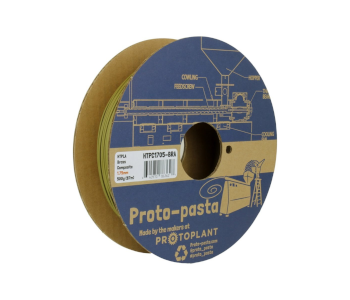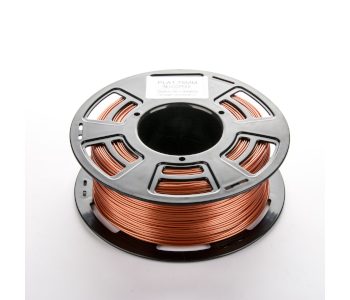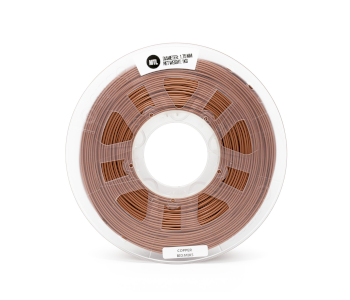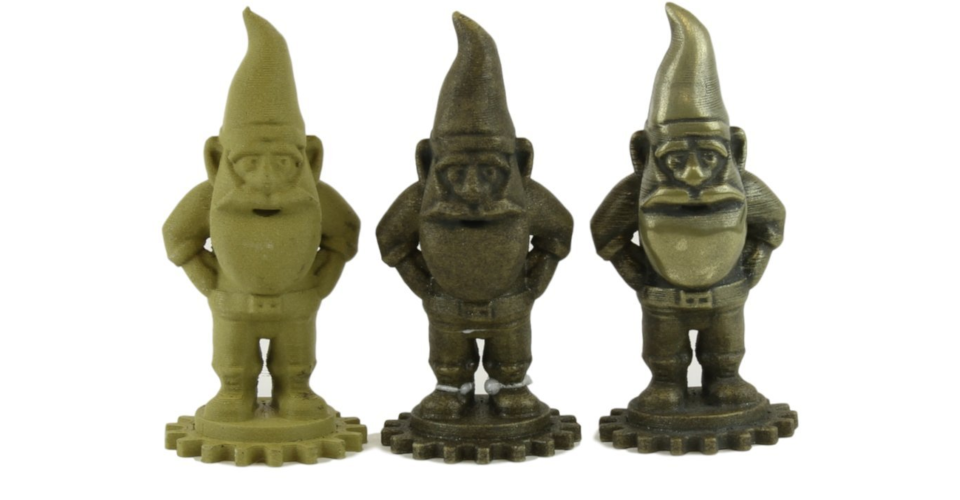Brass Filament: Properties, How to Use, and Best Brands
Plastic may be one of the most versatile materials ever created by man and may have been instrumental in jumpstarting the modern boon of commercial goods, but it can look pretty dull. This becomes even more obvious when you put a plastic object side-by-side with something made of wood or metal. By the same line of reasoning, 3D printing hobbyists can sometimes grow tired of the aesthetics of plastic and prefer something with a little more flair.
In this article, we take a look at one of the filaments that can add a bit of oomph to your 3D prints: brass filament. What are the properties of brass filament and what parameters should you set for your 3D printer? What are the best brands of brass filaments available today?
What is brass filament?
As with other composite filaments, brass filament is simply a combination of a solid powder with a plastic matrix. In this case, the solid powder is brass – an alloy made with mostly copper or zinc. In terms of appearance, brass looks very similar to bronze because of the presence of copper. Both brass and bronze may also contain trace amounts of other elements such as aluminum, silicon, and manganese.
The line of distinction between bronze and brass has been blurred through the years, with many references instead using the less ambiguous term ‘copper alloy.’ A similar trend can be observed in 3D printing filaments, with brass, bronze, and copper filaments often used interchangeably to refer to the same thing.
Throughout history, brass has been valued for its attractive gold-like appearance. In the realm of 3D printing, this is the same appeal of brass filament. It looks great when printed and can look even better when sanded and polished.
Brass filament properties
Depending on the brand, a brass filament can be quite expensive. You’ll also need to learn how to work with it and replace some of the stock parts of your printer. What makes brass so special and why do people bother with it?
1. Excellent visual appeal
The best reason to try out a brass filament is how good it looks. The reddish-gold tint of brass is truly a sight to behold, especially if you can get its luster to show through post-processing. From afar, you might even be able to fool some people into thinking that you have a custom piece made from solid brass. Brass filament is an excellent material for printing custom trinkets, jewelry, design accents, and display pieces.
2. Hefty material
Brass is heavy, and its addition to a basic plastic material makes the filament feel a lot more dense than usual. This gives items printed using brass filament a nice heft which enhances its more ‘premium’ feel.
3. Poor bridging characteristics
The extra weight added by the metals also has disadvantages, particularly during the printing process. If your model has bridges or overhanging features, the higher density of the filament may make it harder to support its own weight even with cooling tuned up to maximum. This could mean that you need to add more support structures than usual.
4. Abrasive solids
This is a common problem with composite filaments, but the effect is a little more dramatic when the solid component of the filament is a metal. The brass particles suspended in the plastic matrix may prove to be abrasive to the nozzle of your 3D printer, creating scratches at the microscopic level. For this reason, you can either switch out your stock nozzle for an all-metal hot end or a nozzle with a wider diameter. Nozzle sizes of 0.5 to 0.6 millimeters have proven to work well with different metal filaments.
5. Rigid but brittle
The addition of solid metal particles to a plastic such as PLA diminishes the durability and flexibility of PLA. This means that you will end up with a print that is rigid but is also brittle. This characteristics brittleness is also something to watch out for in the filament – make sure that the filament strand has a clear path from spool to the extruder, lest it may snap somewhere halfway. Brass filament prints may look good, but we sure won’t use them for parts that need to withstand a lot of stress.
How to use brass filament
Metal filaments are very common nowadays, and one product may differ significantly from another in terms of the optimal print settings. This means that the settings we are providing here may not be what works best for your particular brass filament. When in doubt, it would be best to follow the instructions provided by the filament manufacturer.
Most brass filaments are based on a plastic matrix made with PLA, which allows them to be printed at pretty low temperatures. Somewhere within the range of 190 to 220 °C should work. Brass particles heat up very quickly because of the presence of copper, so we suggest starting at the lowest recommended temperature and working your way up just until you run into any stringing problems.
Another advantage of the metal powder embedded into brass filament is that it retains heat longer than plastic, making metal prints less prone to warping. A heated bed may not be necessary when working with brass filament. However, if you have one, then it would still be better to set it at a temperature of 45 to 60 °C to help with bed adhesion.
If you are printing on a non-heated bed, a layer of blue painter’s tape should work well to improve adhesion. On a heated bed, a more heat-stable adhesive would work better, such as glue stick or hairspray. You should not have to use high-end adhesion aids like PEI sheets or BuildTak surfaces when printing with brass filament.
Since the metal powder in brass filament heats up quickly, the filament can flow smoothly even when you set the printer speed to high. We have tried printing at up to 80 mm/second with good results, but we suggest playing it safe at 50 mm/second and increasing the speed by small increments. Again, setting the printer speed to high can result in stringing.
Speaking of stringing, it may be a significant issue if your model involves a lot of gaps where the print head needs to move across the build platform without extruding filament. The presence of solids in the filament makes it more difficult for the filament to form a seal on the nozzle. This makes it easier for molten filament to ooze out and create “strings” in your print.
If you’re having this problem, it would be best to reduce your printing temperature and speed settings. Enabling retraction isn’t going to help much when printing with brass filament.
As with PLA, there shouldn’t be any problem activating cooling at 100% when printing with brass filament. We still recommend having no cooling for the first two layers so that bed adhesion does not suffer.
Top 3 best brands of brass filaments
Looking specifically for a “brass filament” may be difficult because of the general lack of distinction between copper, brass, and, bronze. These three metal filaments don’t really vary much by their physical properties and look quite similar to each other. Our suggestion is to just go with whichever filament looks best for you, regardless of the label.
1. Proto-pasta Composite Brass HTPLA

One of the few filaments in the market that is branded solely as a “brass filament,”, this PLA-based filament from Proto-pasta has been heat-treated for use up to 160 °C. It comes in the usual cardboard spool that Proto-pasta has been known for. While this is a great move for keeping the product eco-friendly, the cardboard does get tend to get damaged during shipping.
A wide-diameter nozzle is recommended for this filament if you want to avoid getting your extruder clogged. As long as you can dial in the proper printer settings, the brass filament should print with no issues. By far, the best quality of this filament is how cool the finished prints look. They come out with this subdued yellowish-gold finish that looks even better with a little sanding and polishing.
At about $50 for a half-kilogram spool, this brass filament is certainly on the expensive side. It’s likely not something you would buy on a whim, but if you already have a project on mind, this filament could very well be worth the investment.
2. Stronghero 3D PLA Copper/Brass/Bronze

Remember when we said that there’s hardly any distinction between copper, brass, and bronze when it comes to 3D printing filaments? This filament from Stronghero is a good example of that phenomenon. That being said, prints made with this filament look closer to copper than brass. If that aesthetic appeals to you, this is a low-cost way to try something new with your 3D printer.
Just like other metal filaments, this composite copper/brass/bronze filament is made with a PLA plastic matrix. The manufacturers recommend printing it at the same settings that you would set your printer had you been printing with standard PLA.
Users who have worked with the Stronghero filament have reported several issues when it comes to printing, mostly related to stringing and clogging. You may have to take it easy on the printer speed and temperature settings to avoid these problems. This may be a case of “you get what you pay for” but finishing high-quality prints with this filament is not impossible.
The results are well worth the effort, though. The copper-tone finish looks really great and will make any finished print pop. This is not bad for a filament that costs just a little more than your usual PLA.
3. Gizmo Dorks Metal Copper Fill Filament

Yes, we realize that this filament isn’t even called a “brass filament.” Although sold as copper filament, the finish of this PLA-based filament from Gizmo Dorks looks close enough to brass that we went ahead and included it in the list.
There’s a good reason for why this filament isn’t ranked higher despite a budget-friendly price: it simply doesn’t contain enough metal particles. It has just enough to provide color to the plastic, but there seems to be no way to give it a metallic finish. It also doesn’t patina well because the “rusted” effect doesn’t show prominently enough.
One thing we can say about this filament is that it’s very easy to print with. Since it has such a low percentage of metal in it, the filament is mostly PLA. The filament is not so brittle, does not have as many issues with stringing, and doesn’t have the heft of other filaments with a higher metal composition.
The Gizmo Dorks Copper Fill Filament could be an attractive option if you’ve never worked with metal-filled filaments before. It’s a good introduction to these filament types that does away with most of the complications.
The roundup
| Material | Brass filament |
| Properties | Excellent visual appeal, metallic finish, hefty and dense, rigid and brittle, contains abrasive metal particles, has a low tendency to warp, prone to stringing |
| Applications | Display pieces, custom jewelry, and trinkets |
| Printing temperature | 190 to 220 C |
| Bed temperature | Heated bed not necessary but recommended; 45 to 60 °C if using heated bed |
| Bed adhesion | Blue painter’s tape if using non-heated bed; glue stick or hairspray if using heated bed |
| Printing speed | 50 to 80 mm/s |
| Cooling | No cooling for the first three layers; 100% cooling for all successive layers |
Brass is possibly one of the most visually pleasing alloys to ever be created. For this reason, a lot of historical artifacts are made with brass or its closely related cousin, bronze. The finish of brass looks a little like gold, but it is much less expensive.
With a brass filament, you can also have a custom-made brass piece displayed in your home or office. It won’t be made of pure brass, of course, but people probably wouldn’t be able to tell from a distance as long as you do a good amount of post-processing. Have you tried printing with brass filament? Tell us about your experience in the comments below!





